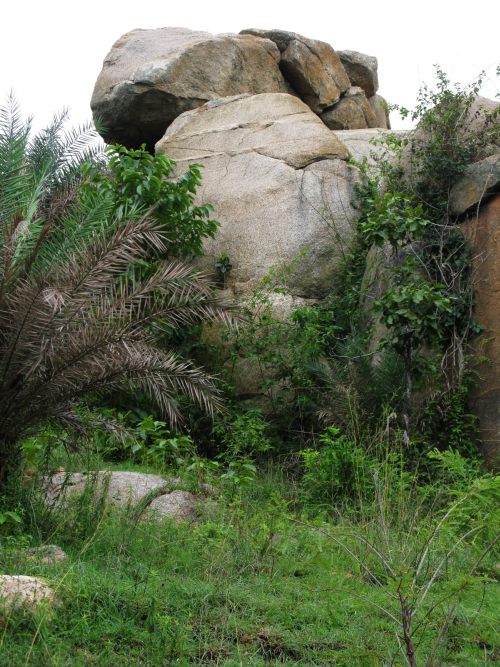
After our day at Nandi Hills and a bit of driving around Bangalore, we thought we were done. Set to leave the following afternoon, we had little to do on the one Sunday morning that remained, besides relax, spend some time with the family, and say our goodbyes. The evening before, we were sitting around the house talking to our cousin, discussing such important world issues as camera equipment, when he mentioned that he was going rock-climbing in the morning. He said his favourite spot was close by, it was a nice bit of wilderness, a decent place to take some photos, and that there are usually plenty of birds to spot. With our trips to Mahim Nature Park and Borivali National Park on the previous two Sundays, we were now on a hat-trick of Sundays spent in nature. It seemed a shame to break a good streak, so plans were made for everyone to take one last sojourn in Bangalore to a little hill in Turhalli.
We were up before dawn, and by the time the sky began to brighten, we had all poured into our ride and were driving towards Turhalli. It was only a few kilometres away, but it was supposed to be a little island of green in the otherwise urbanised city. Bengaluru is laid out in a very splattered and spread out pattern, very different from the coastal cities and towns I know well, so it’s quite easy to be surprised by distances and changes in scenery. It was a slightly chill morning and a light mist hung around the sides of the roads. We were soon out of the small streets of our area and out on bigger roads where out-station busses were roaring into life and starting off down the highway to their distant destinations.
In one or two places the road turned into a make-shift morning market, with vegetable and flower sellers lining both sides of the street. Men dressed up in whites and grays out of habit from their days at a desk rambled between the hawkers with newspaper in hand, waiting for their accompanying wives to make their purchases for the day, so that they could do their duty as the designated driver of their two-wheelers. And as always, some still had to work on a Sunday. A young man in a crisp white shirt, seemingly on his way to an office job, drove his bike down the street. His father, carrying a vegetable-sellers basket carefully balanced on his head, rode pinion. They were having an animated conversation over the roar of the motorbike as they drove by.
After all the activity, the buildings thinned out suddenly, the trees got taller, and while we were still just a few kilometres from the centre of the city, it seemed like we had left it behind. Near a petrol station, our cousin asked the driver to turn off the highway along a narrow road. A few twists and turns, and we were driving through a village. It was a modern village, with brick houses, and even a one computer internet cafe, but a village nonetheless. This was Turhalli. (Halli is village in Kannada)
Curious children stopped and looked up at the new arrivals as we drove through, and we soon left the little village behind and headed off toward higher ground. A large hill was clearly visible a few hundred metres from the settlement. Except for the dark grey line of the road, everywhere was green, with grass and weeds having over run every available square foot of fertile deccan soil after a few showers. Further down, the road hugged the base of the hill and went around it, so we stopped just before it did and walked off the tar.
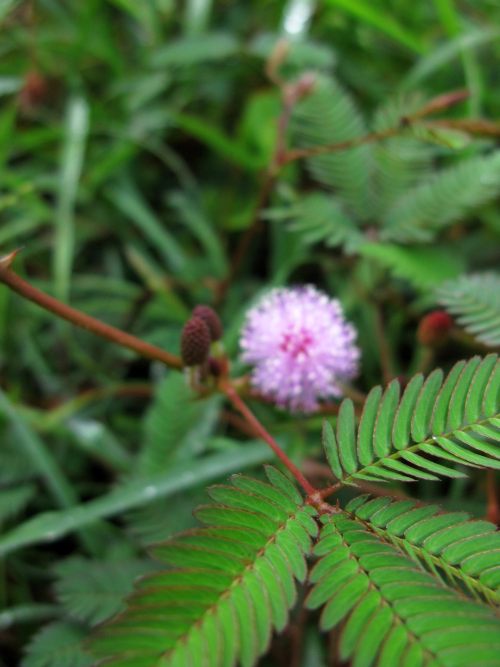
A muddy path snaked towards a lush grove of trees at the base of the hill, but before that, to the right, a large banyan tree stood as sentry to this landscape, it’s hanging roots intertwited with its ancient trunk forming a sinewy column a few metres wide. Of course, there were the mandatory iconic declarations of love scratched into the bark, to indicate that even this place was not untouched by human hands. But largely, the landscape looked fresh and pristine. The grove of trees loomed large as we walked closer, and it soon became clear they were all some sort of eucalyptus variant. The shedding white bark was quite unmistakable, and the slender curving leaves rustled in the wind. When we entered the shade of the grove, the ground was invisible because it was carpeted with a thick layer of browning sickle-shaped leaves. With the moisture of the season the carpet of leaves had a rubbery quality, my feet seemed to sink in a little with every step, with the mesh of leaves springing back when I passed.
Other shrubs and trees began to make an appearance as the grove began to thin and the ground climbed upward. Small butterflies and insects flitted around in the morning air, and we were soon scaling the side of the hill on a rough path made of equal parts rock and rusty soil. The path was not graded or prepared in any way, but had slowly formed as frequently passing human feet had hewn a line across the less trecherous inclines of the hillside. There were a few tricky areas, more so because of the slippery grass, but in general it was a fairly easy climb, with shrubs and trees to hold on to, and moist mud to dig into when needed. In my childhood I have climbed much drier and more rocky slopes than this one in Oman. Compared to some of those, this was just a stimulating morning walk up a hill.
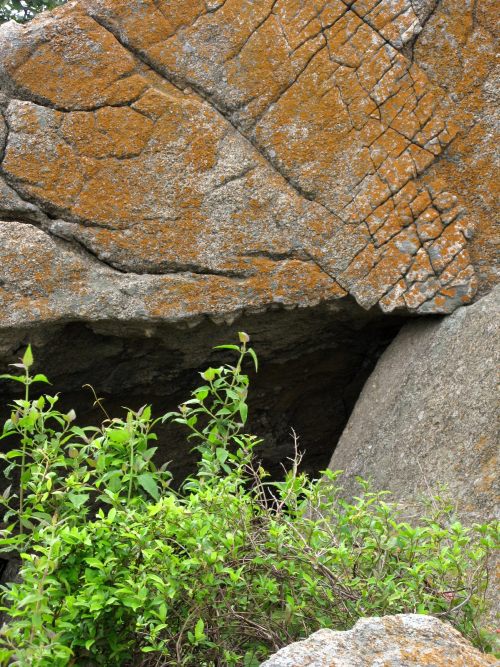
Karnataka, and especially the region around Bangalore, has a peculiar geology that lends itself to many such hills strewn with megalithic boulders teetering in precarious positions. It is a magnificent sight. The top of the hill we were climbing was clearly rocky even when seen from the base, which is why it was popular with rock climbers. As we neared the higher reaches of the hill, the boulders loomed large. Out of the mud, stones and shrubbery, towering pieces of rock, smoothened by millennia of weathering, thrust themselves skyward, sometimes standing alone, and sometimes in complex balanced piles. Most of them had smooth corners that made them look like giant pebbles, but as you got closer more detail appeared. Their faces were rough, as if chiseled into an even surface, and many of them were brightly coloured by the yellow lichen growing on them.
Navigating around the various rock arrangements, we made our way to the flatter areas at the top of the hill. We had come up almost at the centre along the length of the hill, and its main spine extended to the right and the left, with higher rocks and trees visible in both directions. We continued towards the left and after a few minutes through mostly even ground we walked past a large towering rock into a clearing. In the clearing was a temple. It was one of those modern temples, with an inelegant box of a structure with a mandatory spire to crown it. The materials used reminded me more of a gaudy private bungalow than of a place of worship, and it’s shiny grilled doorway was closed and quiet at this early hour. In front of the main structure some further statuettes and pedestals had been erected, one with a rough likeness of a what looked like a crow in black stone, facing the temple entrance. This temple was a new addition on what had been an untouched bit of nature, after the requisite person in power had seen the requisite vision to build a temple here. As with all religious issues, this invasion had gone largely unchallenged, and thus it always begins.
As I stood in the clearing, I was wondering how anyone came up to this temple, because if there’s one thing I’ve learnt about the faux-spiritual crowd, it is that they are only as spiritual as it is convenient. You can be sure none of them are going to climb up the way I just described unless you were paying them. I was proved right soo enough. As we walked past the clearing a broader path opened up and then snaked to the side into a wide muddy road. It was now gutted by the rains, but it was just wide enough for a car to crawl up to the summit from the back of the hill. Quite tellingly, it was the first patch of mud I had seen since we got off the road which was completely devoid of all vegetation and life. The price of human religious politics is often too high.
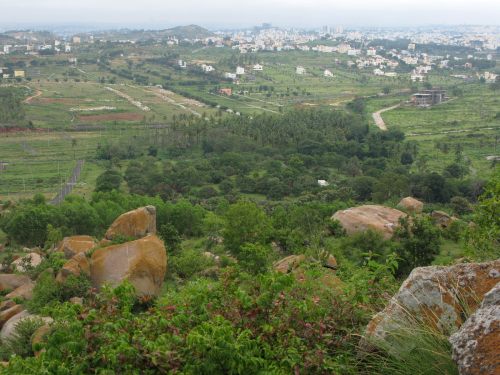
From where the make-shift dirt road mounted the summit, you could see other signs of the inevitable human encroachment. We were told the green ruled as far as the eye could see even a decade or so ago, when my cousin first started coming to this place, but now the concrete sentinels of human development could be seen a mere few hundred metres from the base of the hill, and all beyond was a patchwork of houses and settlements, creeping ever closer.
We turned around and went back the way we had come, to explore the other half of the hill-top. Wild flowers grew everywhere between the rocks and even the grass on the path still held healthy reservoirs of dew from the moist morning air. Eventually we ended up in a dense cluster of rocks at the other end of the hill, and skipped and jumped on and around them to make our way to some flat areas which were perfect for sitting on and looking on to the world. It was more of the same, white specks of buildings growing ever closer, and there was even an entire layout of plots, streets and streetlights that was ready and waiting to be built on at the first flat land available beyond the base of the hill.
For now, it was still a beautiful place. The lichened rocks were welcoming and the green that surrounded us imparted that characteristic electricity to the air that is invigorating at all times of the day, but even more so during the pristine hours of dawn. We sat there for a while and enjoyed the breeze. This was nowhere as high as we had been on the summit of Nandi Hills, but once again that calm I have mentioned before, which permeates the higher reaches of the Earth, was there, and I enjoyed it while it lasted.
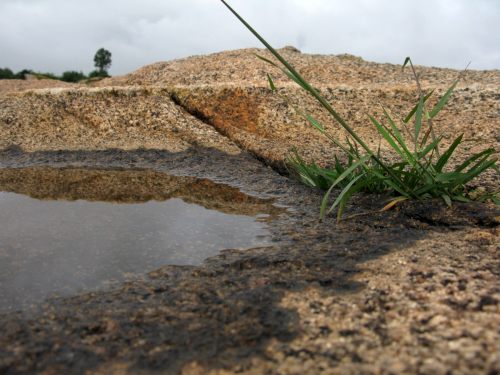
In all this exploring we’d forgotten that our cousin had come here to do some rock climbing, so while we enjoyed the view, he went off to the other side of this rock formation with the crash pad he’d been carrying all this time, to to do some climbing. After getting our fill of the sights off the edge of Turhalli Gudda (Gudda/Gudde is hill or mountain in Kannada), we made our way over and through the maze of rocks to where he had headed.
The other side of the hill-top faced eastward, and the Sun was peeking through some dense clouds near the horizon, lighting up the rocks to look even more magnificent. We walked onto a wide table of rock 10 or 15 metres wide that over looked the side of the hill. This is where we had initially come from, our waiting vehicle could be seen on the road far below, and the village shimmered in the distance. On this flat rock, there was balanced a much larger boulder that stood tall, leaning against another that formed a small platform about halfway up it’s height. It was on this platform, a few metres above where we stood, that we found our intrepid rock climber standing casually, looking into the sunrise.
He climbed effortlessly down the sheer rocky incline, from the higher platform to where we stood. The large rock that towered above was called Krishna by the climbers, and one sheer vertical face of it was said to be one of the most difficult climbs on this hill, because to reach the summit you had to put your faith in a small gash in the rock a few metres off the ground that was barely an inch thick. The way he had just come down, however, was supposed to be a great beginners climb to try out and he asked if we wanted to give it a go. Never being the ones to step back from climbing anything that will allows us, we said yes.
There was a large gash that separated the tall standing rock from the shorter one with the platform. This line rose up at a steep angle and was the way to get up to the first level. When it was my turn, I took off my slippers, because I’ve always preffered the tactility of bare feet for things like this, stepped up and tried to get the first foothold. Immediately I slipped back down. The rock was smoother than you thought when it came to supporting your entire weight. I was told to wipe the bottom of my feet on the legs of my pants to get rid of the sand. That would give me more grip. I did and it worked, for the first step anyway. After that, the rock still loomed large and it’s at times like this that your mind goes blank in confusion. But, my left hand was holding on to that gash between the rocks, and old memories kicked in at that point. I pushed myself into the gap with my back against the edge, with my hands and feet holding on to other surfaces as best as they could, and before I knew it I was on the platform. That had been both harder and much easier than I had expected but it was exhilarating to stand there.
There was no point coming this far and not trying for the higher summit. It was supposed to be fairly easy if done carefully. From the platform, the rest of Krishna curved upwards to the top, so after the initial boost off the platform, you were basically spread out, precariously hugging the side of a large pebble. Then it was a matter of keeping your arms and legs moving till you went over the edge to the flat portion on the top.
Even compared to the intermediate platform, the top of the rock was quite high and narrower. After a little huffing and puffing, when I reached the top I remained on my haunches for a few seconds, because the effort makes your muscles tremble and you’re not quite ready to stand errect on what, at that point, seems a precariously small bit of flat rock very high in the air. Eventually I did stand, and I am not exaggerating when I say that it was one of the best feelings I had had in a long time. It had been too long since I’d felt this rush of getting to the top of a challenging climb, and then looking down on the World through new eyes.
The top had a small depression towards the centre of the rock where dew had collected into a small puddle, and a tuft of grass grew along the edges. The photo above is of that puddle on the highest point. In the distance is a tree on some other rocks towards the centre of the hill, which is probably the only other thing as high as where we stood. Four of our group made it to the very top before we left, and the few minutes we spent there made the entire trip to Bangalore worth it.
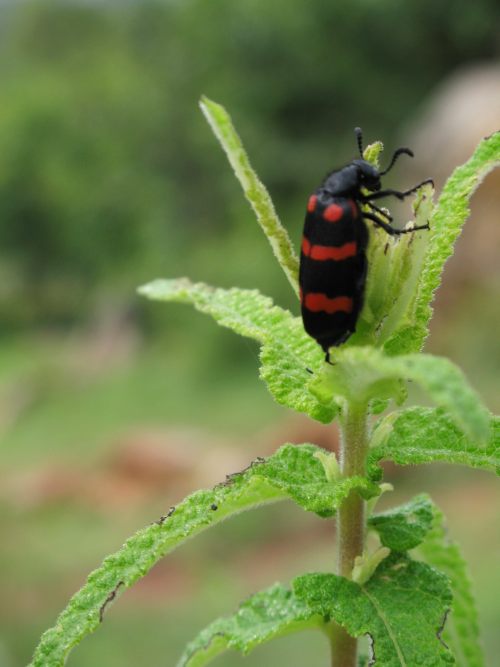
Eventually we climbed down from our rocky perch on top of the world, and headed back down the hill. We were still climbing down the same hillside but this was a different path that bypassed the grove of trees we had walked through on our way up. This path was more stepped with rocks, and many more detours into interesting fissures and small thickets were there to be explored. After the excitement on the hill-top we were all quite stoked, so our cameras were active and we noticed more than we normally would have, spotting well camouflaged insects and tiny flowers that were hidden in the midst of this natural cornucopia.
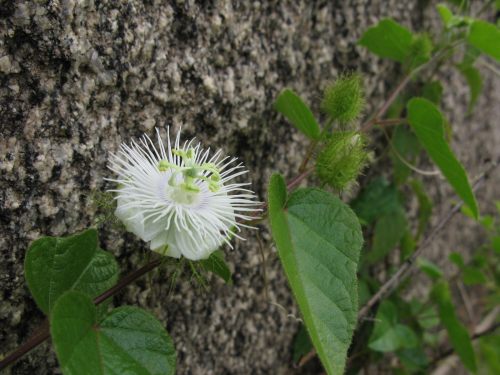
Half way down the slope we came to another collection of standing rocks. One in particular was getting a lot of attention from a group of rock climbers who were practicing on it. Well, one of them was trying to make the climb, while the others encouraged her along and gave her pointers about her next move. I always find it fascinating how a sport creates its own jargon, to the point where the enthusiasts can only understand each other, even when what they are actually saying is just as easy to say in the common tongue. I guess we all like to belong, and part of that belonging involves the exclusion of everyone else. It’s a strange phenomenon, and as we studied and peered at the nature around us, I’m sure nature was peering back at us, the silly human specimens.
The slope became more gradual as it started to level off at the base of the hill. Larger trees were now well spaced around us, and as we made a turn towards the road we were back at the sentinel banyan tree where we had started our journey. Our group was quite spread out, some hanging back to take more pictures while others continued forwards. As I was still a little distance away from the banyan tree, I saw one of the others standing below it, looking up, and for the first time I realised just how tall it was. The human figure was completely dwarfed by a tree that must have been at least a few storeys high, and its canopy was probably just as wide. It was a startling reminder of how much of nature is always more complex, intricate, and vast than we can fathom. Or, in our self-absorbtion, we just fail to see it.
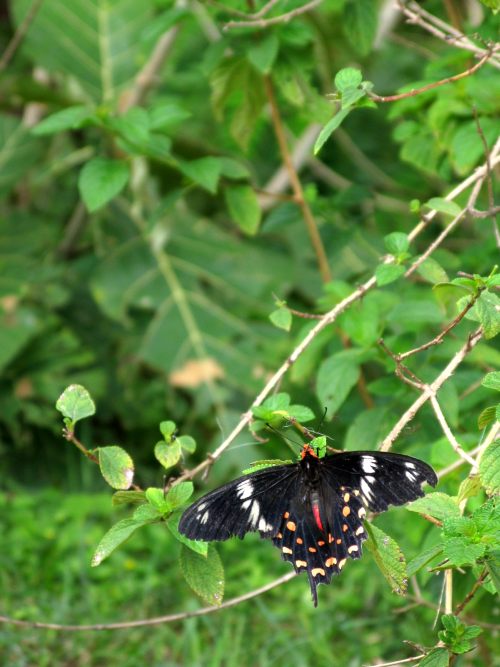
The Sun had started to break through the clouds and it lit up the trees along the path. Just a metre or so from the tar, where our vehicle was waiting, we spotted a huge black and red butterfly basking in the warm sunlight on one of the shrubs. It was close enough to touch and as we carefully approached, always clicking and never knowing when it would decide to fly away, it remained in its place. Most us us managed to get our cameras to an arm’s length away from the insect without spooking it. It was around six inches wide, black, with white, red and yellow markings. It was a tailed butterfly, but the entire tail section of its right wing had been ripped off, probably sacrificed during an escape from a predator. It swayed in the dawn light, bruised, unbeaten, and magnificent.
We took one last look at the little island that was Turhalli Gudda, and drove away. Of all the trips I have ever taken to Bangalore, and all the places I have visited, that one place is the one I would most want to return to, and I pray there is still enough of it left when I see it again. My only hope is that nature is a lot more resilient to human stupidity than we give it credit for.
Samir
Liked this article? Please share it: ![]()
![]()
![]()
![]()
![]()
![]()
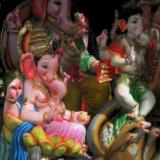
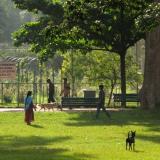
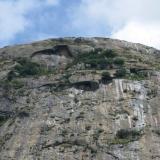
Samir, this post has given me a wide vision of what you saw on your visit, what impresses me is your ability to descrive things, choosing the exact words that make reality look even prettier.
Magali